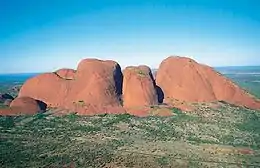Bornhardt
A bornhardt (pronounced /ˈbɔrnˈhɑrt/) is a big dome-shaped, steep-sided, bald rock formation.[1][2] They are a kind of inselberg. They are usually made up of granites or gneisses, but can sometimes be found in other rock types like limestone, sandstone and conglomerate. They are named after Wilhelm Bornhardt (1864–1946), the German geologist who first described the feature.[3][4]

The Olgas, central Australia

Sugar Loaf Mountain, Rio de Janeiro
References
- Allaby, Michael (2004). A Dictionary of Ecology (2nd ed.). Oxford University Press. ISBN 0198609442.
- Mayhew, Susan (2004). A Dictionary of Geography (3rd ed.). Oxford University Press. ISBN 0198606737.
- "Glossery of Terms: Bornhardt". Yonsei.ac.kr. InfoCenter for Environmental Geology. Archived from the original on 27 October 2011. Retrieved 12 March 2012.
{{cite web}}: More than one of|archivedate=and|archive-date=specified (help); More than one of|archiveurl=and|archive-url=specified (help) - Twidale, C R; Romaní, J R V (2005). "Inselbergs and Bornhardts". Landforms and Geology of Granite Terrains. New York: A.A. Balkema. pp. 109–116. ISBN 0415364353.
More reading
- Twidale, C R (1981). "Granitic Inselbergs: Domed, Block-Strewn and Castellated". The Geographical Journal. 147 (1): 54–71. doi:10.2307/633409. JSTOR 633409.
- Twidale, C R (2007). "Bornhardts and associated fracture patterns". Revista de la Asociación Geológica Argentina. 62 (1): 139–153. ISSN 0004-4822.
Other websites
- Granite Inselbergs of the Central Namib Deserts Archived 2013-05-02 at the Wayback Machine
- Boulders/Tors/Inselbergs Archived 2010-04-18 at the Wayback Machine
This article is issued from Wikipedia. The text is licensed under Creative Commons - Attribution - Sharealike. Additional terms may apply for the media files.